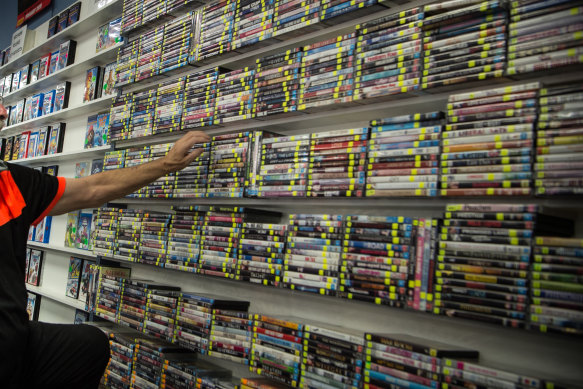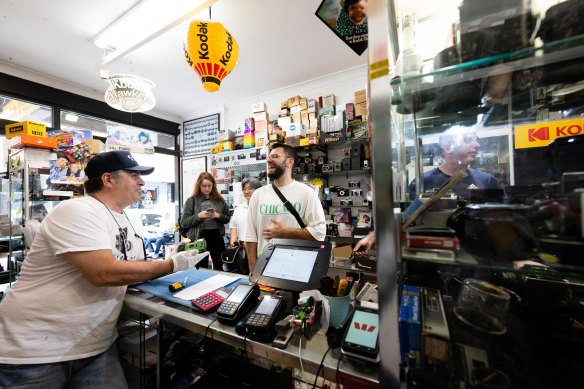‘It’s a wake-up call’: The industries that have lost nine in 10 workers in the past decade

Some high-profile industries have shed more than nine in 10 workers over the past decade as changes in technology and shifting consumer preferences reshape employment in Australia.
The number of jobs in the video hire industry has plummeted as viewers switched to digital streaming services such as Stan and Netflix. In 2011, there were 7551 jobs in the “video and other electronic retail and hiring” industry, but that shrank to just 162 by 2021, a fall of 98 per cent.
The video hire industry has been decimated compared with decades past. Credit:Wolter Peeters
Analysis of census data by this masthead shows employment in cigarette and tobacco product manufacturing suffered a similar fate – plunging from 1685 workers to only 28 in the decade, also a decline of 98 per cent.
Other segments of manufacturing also registered big falls in employment including steel pipe and tube manufacturing (-83 per cent) and motor vehicle manufacturing (-59 per cent).
Among the biggest employment increases over the past decade have come in IT, especially web-based services, construction and health-related services.
The fastest job growth was in residential building not including freestanding houses – that industry segment added 39,054 workers, a rise of 537 per cent in the decade. The next fastest was the data processing and web hosting service industry with a 485 per cent increase.
Big gains were also posted in pre-school education (231 per cent), courier pick-up and delivery services (189 per cent) and physiotherapy (111 per cent).
Sydney University workplace researcher Professor John Buchanan said the slump in manufacturing employment coincides with the withdrawal of government support for key parts of the sector, especially the car industry.
While some manufacturing businesses remain strong, especially in food and beverages, he warned the decline of sophisticated parts of the sector such as the car industry threatened to undermine Australia’s skill base and reduce the diversity of employment.
“It’s a wake-up call,” Buchanan said. “Unless we make a conscious choice to build up our manufacturing base it will wither and die completely.”
He said problems caused by supply chain disruptions during COVID-19 underscored the importance of having a domestic manufacturing capability.
One branch of manufacturing which has thrived is beer making. The census shows employment in beer manufacturing jumped 58 per cent between 2011 and 2022 amid rapid growth in local microbreweries.
The fortunes of the photographic film processing business underscores how quickly consumer preferences can shift.
One-hour photo labs were once ubiquitous in suburban shopping strips, but they began to disappear as photographers switched to digital cameras during the early 2000s. Employment in photographic film processing plummeted by 55 per cent between 2011 and 2021, the census shows.
Now film photography is in the midst of a niche resurgence. Nick Vlahadamis, the owner of an “old school” camera and film shop in Newtown called Sydney Super 8, says business is booming. It is one of a handful of stores in the city that still sells and processes film.
Nick Vlahadamis at his Sydney Super8 store in Newtown where the sale and processing of film is booming. A recent revival in film photography follows years of declining employment in the film processing industry.Credit:Photo: Janie Barrett
Vlahadamis says a revival in film photography, which began about four years ago, was “super-charged” during COVID-19 when many people had more spare time.
“Ten years ago when we started it was just a hobby that we wanted to share with people,” he said.
“We reinvented ourselves as a retro film place, and now it’s just taken off, it’s crazy … I’ve got an 83-year-old camera technician who has got more work now than when he retired in the 1990s.”
Healthcare and social assistance emerged as Australia’s biggest overall employer in 2011 and the latest census showed big increases in absolute job numbers in that sector. Employment in hospitals (except psychiatric) rose by 52 per cent in the decade to 2021 (to 545,158 workers) while social assistance services more than doubled in that period (to 278,221 workers).
Buchanan described the healthcare and social assistance industry as “the old man river” of Australian labour market growth because it “just keeps on rolling.”
About one in every seven Australian workers is now employed in healthcare and social assistance.
The census also revealed how workers in some fast-growing industries have settled in high numbers in certain districts.
One example is the cluster of computer system design and related services industry employees who live in the Parramatta area of Sydney. More than one in twenty working-age residents in this area work in this sector, the highest concentration of those workers in Australia.
The computer system design and services industry ranked among the nation’s fastest growing in the decade to 2021 – increasing by 82,303 to 221,712 workers in that period, a jump of almost 60 per cent.
Inner-city Melbourne is home to an unusually high concentration of cafe and restaurant workers. The industry employs more than one in 20 people of working age in the area.
This masthead chose to use industry instead of occupation data for this analysis because the Bureau of Statistics defines occupations in general terms. For example, the driver of a coal trucks’ occupation is ‘truck driver’, however, the industry they work in is coal mining and not transport.
Most Viewed in Business
From our partners
Source: Read Full Article


